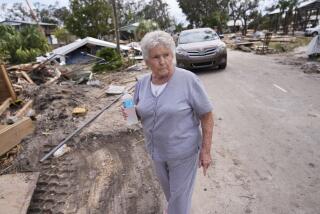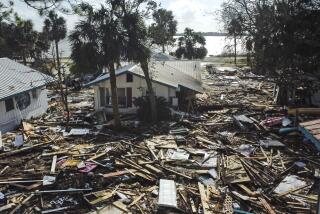Florida’s Lower Keys Evacuate for Michelle
- Share via
MIAMI — As Michelle, a dangerous late-season hurricane, chugged northward through the Caribbean, authorities Saturday ordered the lower Florida Keys evacuated of tourists and residents as a precaution.
A string of small, low-lying islands more than 50 miles long, stretching from Key West to Marathon, was ordered emptied of its population by local authorities, said Harold Joiner, manager at the Florida Division of Emergency Management.
“If law enforcement wants to push it, they could arrest,” Joiner said from Tallahassee, Florida’s capital. “But typically, they get the next of kin to do some persuading.”
Joiner said the evacuation order, issued by Monroe County authorities, could affect 60,000 to 70,000 Keys residents. As many as 20,000 tourists and visitors were covered by a separate evacuation order issued earlier, Joiner said. Gov. Jeb Bush declared a state of emergency.
Michelle was a powerful Category 4 storm, on a scale of 5, with sustained winds of nearly 135 mph, and could get even stronger, the U.S. National Hurricane Center in Miami said. Saturday evening, the storm’s eye was about 235 miles south-southwest of Havana.
Already Saturday afternoon, Key West, the southernmost point in the Florida Keys, was being buffeted by gusty blasts, and visitors were doing their best to leave before Michelle got too close.
“All the tourists are heading out and trying to find ways to get out of town,” said Blake Ireland, the front-desk clerk at the 15-room La-Te-Da Hotel, where 12 people checked out during the day. “The airport’s a mess, and there are no more rental cars.”
“We just put someone in a taxi for Miami--a $400 fare,” Ireland said.
The bulk of the evacuees were expected to drive northeast toward Miami on U.S. 1, known locally as the Overseas Highway, Joiner said. In the Miami area, permanent shelters are already in place for Keys residents who are forced to flee great storms.
In September 1998, Hurricane Georges forced the last large-scale evacuation of the Keys archipelago, the southernmost point in the continental United States. Before evacuation plans existed, a fearsome hurricane on Labor Day 1935 killed 408 people in the island chain.
Michelle’s landfall in Cuba was expected sometime tonight, and residents of the Communist-ruled country lined up at gas stations and spent valuable U.S. dollars on storm provisions at hard-currency stores.
“It’s a bad one,” a worried Havana vegetable vendor told a foreign journalist. In Cuba’s capital and largest city, residents crowded markets and stores to load up on emergency food stocks. Authorities ordered 150,000 people evacuated from flood-prone areas around the city.
In Havana and Varadero, to the east, plans were in place to evacuate foreign tourists if necessary and move them to government shelters, Cuban state-run media reported.
On its northward path, Michelle has already doused Central America and Jamaica with five days of rain that killed 12 people, left 26 missing and forced more than 115,000 to flee their homes.
“This is a very strong and dangerous storm,” warned Jamie Rhome, a meteorologist at the U.S. National Hurricane Center. In the next 48 hours, Rhome said, Michelle is expected to cross Cuba and enter the Straits of Florida.
Once in the narrow channel between Cuba and Florida, Rhome said, the hurricane is expected to be steered increasingly eastward, and away from Florida, by another weather system.
“If our forecast holds, Michelle would miss the Keys to the south and move toward the Bahamas,” Rhome said. High-altitude winds should also start sapping the storm’s force sometime today, the meteorologist said.
As residents of Florida and the Caribbean well know, however, hurricane prediction is no exact science. Memories are still vivid of Hurricane Andrew, a Category 4 storm that gouged a path of appalling devastation across Florida in 1992. The last hurricane to strike Cuba, Lili, was rated only a Category 3, but it destroyed crops and left thousands homeless five years ago.
On Saturday afternoon, Max Mayfield, director of the U.S. National Hurricane Center, acknowledged that Michelle’s wobbly track might alter to the point where a hurricane warning has to be issued for populous South Florida.
A 10-degree shift in Michelle’s path would “make all the difference in the world,” Mayfield said.
Miami-Dade Mayor Alex Penelas called on residents to stock up on food, water, batteries and any prescription medicines they require as a precaution. Even with the hurricane well to the south of Cuba, Florida’s Atlantic Coast was being lashed by high winds and a heavy storm surge. Penelas said winds in the Miami area were expected to reach tropical-storm force by 3 a.m. Monday.
In Cuba, a hurricane warning was in effect for most of the western provinces. In Pinar del Rio, agricultural workers rushed to harvest the tobacco leaves used to make some of the world’s best-known cigars.
Times researcher Anna M. Virtue in Miami and the Associated Press contributed to this report.
More to Read
Sign up for Essential California
The most important California stories and recommendations in your inbox every morning.
You may occasionally receive promotional content from the Los Angeles Times.













